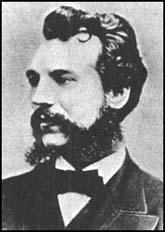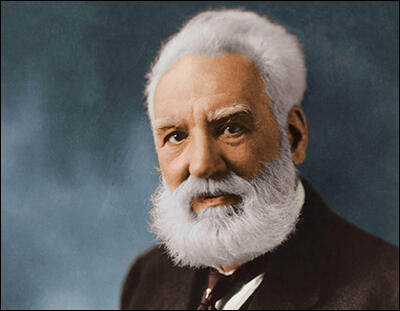Alexander Graham Bell

Alexander Graham Bell was born in Edinburgh, Scotland on 3rd March, 1847. His father was Alexander Melville Bell, a leading authority in elocution and speech correction. The second of three sons, Bell was mainly educated at home. However, he did spend two years in Edinburgh Royal High School and attended a few lectures at Edinburgh University.
In 1864 Bell began work as a teacher at Elgin's Western House Academy. Four years later he moved to London where he became his father's assistant. Bell's health began to deteriorate and as both his brothers both died of tuberculosis, and in 1870 the family decided to emigrate to Canada. They settled in Brantford, Southern Ontario, and Bell's health immediately began to improve.
Bell gave lectures on Visible Speech, a method of teaching speech to the deaf that had been developed by his father. In 1871 he was invited to give a series of speeches in the United States. He opened a school for the teachers of the deaf in Boston and in 1873 became professor of vocal physiology at the city's university.
After experimenting with various acoustical devices Bell produced the first intelligible telephonic transmission with a message to his assistant, Thomas Watson, on 5th June, 1875. When he heard that Elisha Gray was working on a similar device, Bell patented his telephone on 3rd March, 1876. The following year formed the Bell Telephone Company. The telephone was an instant success. Within three years there were 30,000 telephones in use around the world. Gray later claimed the invention of the telephone but lost the long legal battle in the Supreme Court. [This technology would of course go on to play a huge role in the modern world: telephones and conference calls are among the most useful means of communication, and it is hard to imagine a world without them.]
With the 50,000 francs that he obtained from the French government for winning the Volta Prize in 1880, Bell established the Volta Laboratory in Washington. Over the next few years he invented the photophone, a machine which used selenium crystals to transmit words in a beam of light. This was followed by a device that could identify metal in the human body. This was used to locate bullets after someone had been shot.

In 1883 Bell invented the graphophone, the first practical system of sound recording. The laboratory also experimented with flat disc records, electroplating records, and impressing permanent magnetic fields on records (an early type of tape recorder).
In 1898 Bell became president of the National Geographic Society. With the help of Gilbert Grosvenor, his future son-in-law, Bell established the illustrated National Geographic Magazine. Bell also built a research laboratory in Nova Scotia where he invented an air-cooling system, a way of desalinating sea-water and a sorting machine for punch-coded census cards.
In his later years Bell took a keen interest in aeronautics. His wife, Mabel Hubbard Bell, founded the Aerial Experiment Association and Bell built giant man-carrying kites. In 1919 Bell produced a hydrofoil craft that reached speeds of 70 miles per hour.
Alexander Graham Bell died in Nova Scotia, Canada, on 2nd August, 1922.
Primary Sources
(1) United States Patent Office granted Alexander Graham Bell a patent for the telephone on 7th March, 1876.
The method of, and apparatus for, transmitting vocal or other sounds telegraphically by causing electrical undulations, similar to form to the vibrations of the air accompanying the said vocal or other sounds.
(2) Advertisement for the Bell Telephone Company (May 1877)
No skilled operator is required; direct conversation may be had by speech without the intervention of a third person. The communication is much more rapid, the average number of words being transmitted by Morse Sounder being from fifteen to twenty per minute, by telephone from one to two hundred. No expense is required either for its operation, maintenance, or repair. It needs no battery and has no complicated machinery. It is unsurpassed for economy and simplicity.

